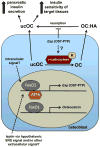Bone and glucose metabolism: a two-way street
- PMID: 20682281
- PMCID: PMC2946845
- DOI: 10.1016/j.abb.2010.07.030
Bone and glucose metabolism: a two-way street
Abstract
Evidence from rodent models indicates that undercarboxylated osteocalcin (ucOC), a product of osteoblasts, is a hormone affecting insulin production by the pancreas and insulin sensitivity in peripheral tissues, at least in part through enhanced secretion of adiponectin from adipocytes. Clinical research to test whether this relationship is found in humans is just beginning to emerge. Cross-sectional studies confirm associations between total osteocalcin (OC), ucOC and glucose metabolism but cannot distinguish causality. To date, longitudinal studies have not provided a consistent picture of the effects of ucOC or OC on fasting glucose and insulin sensitivity. Further exploration into the physiological and mechanistic effects of ucOC and OC, in rodent models and clinical studies, is necessary to determine to what extent the skeleton regulates energy metabolism in humans.
Copyright © 2010 Elsevier Inc. All rights reserved.
Figures


Similar articles
-
Crosstalk Between Bone and Fat Tissue: Associations Between Vitamin D, Osteocalcin, Adipokines, and Markers of Glucose Metabolism Among Adolescents.J Am Coll Nutr. 2017 May-Jun;36(4):273-280. doi: 10.1080/07315724.2016.1274923. Epub 2017 Apr 26. J Am Coll Nutr. 2017. PMID: 28443718
-
No Evidence of Association Between Undercarboxylated Osteocalcin and Incident Type 2 Diabetes.J Bone Miner Res. 2022 May;37(5):876-884. doi: 10.1002/jbmr.4519. Epub 2022 Feb 27. J Bone Miner Res. 2022. PMID: 35118705 Free PMC article.
-
Undercarboxylated osteocalcin can predict insulin secretion ability in type 2 diabetes.J Diabetes Investig. 2017 Jul;8(4):471-474. doi: 10.1111/jdi.12601. Epub 2017 Jan 25. J Diabetes Investig. 2017. PMID: 27889949 Free PMC article.
-
Undercarboxylated Osteocalcin: Experimental and Human Evidence for a Role in Glucose Homeostasis and Muscle Regulation of Insulin Sensitivity.Nutrients. 2018 Jun 29;10(7):847. doi: 10.3390/nu10070847. Nutrients. 2018. PMID: 29966260 Free PMC article. Review.
-
The endocrine role of the skeleton: background and clinical evidence.Eur J Endocrinol. 2012 Jun;166(6):959-67. doi: 10.1530/EJE-12-0030. Epub 2012 Mar 21. Eur J Endocrinol. 2012. PMID: 22436399 Review.
Cited by
-
Effect of calcitriol on bone turnover and osteocalcin in recent-onset type 1 diabetes.PLoS One. 2013;8(2):e56488. doi: 10.1371/journal.pone.0056488. Epub 2013 Feb 20. PLoS One. 2013. PMID: 23437144 Free PMC article.
-
Undercarboxylated osteocalcin does not correlate with insulin resistance as assessed by euglycemic hyperinsulinemic clamp technique in patients with type 2 diabetes mellitus.Diabetol Metab Syndr. 2012 Dec 18;4(1):53. doi: 10.1186/1758-5996-4-53. Diabetol Metab Syndr. 2012. PMID: 23249601 Free PMC article.
-
Human vascular cell responses to the circulating bone hormone osteocalcin.J Cell Physiol. 2019 Nov;234(11):21039-21048. doi: 10.1002/jcp.28707. Epub 2019 Apr 26. J Cell Physiol. 2019. PMID: 31026070 Free PMC article.
-
Determinants of undercarboxylated and carboxylated osteocalcin concentrations in type 1 diabetes.Osteoporos Int. 2012 Jun;23(6):1799-806. doi: 10.1007/s00198-011-1807-7. Epub 2011 Nov 9. Osteoporos Int. 2012. PMID: 22068385 Free PMC article.
-
Metabolic alterations in the bone tissues of aged osteoporotic mice.Sci Rep. 2018 May 25;8(1):8127. doi: 10.1038/s41598-018-26322-7. Sci Rep. 2018. PMID: 29802267 Free PMC article.
References
-
- Kemink SA, Hermus AR, Swinkels LM, Lutterman JA, Smals AG. Osteopenia in insulin-dependent diabetes mellitus; prevalence and aspects of pathophysiology. J Endocrinol Invest. 2000;23:295–303. - PubMed
-
- Bouillon R, Bex M, Van Herck E, Laureys J, Dooms L, Lesaffre E, Ravussin E. Influence of age, sex, and insulin on osteoblast function: osteoblast dysfunction in diabetes mellitus. J Clin Endocrinol Metab. 1995;80:1194–1202. - PubMed
-
- Auwerx J, Dequeker J, Bouillon R, Geusens P, Nijs J. Mineral metabolism and bone mass at peripheral and axial skeleton in diabetes mellitus. Diabetes. 1988;37:8–12. - PubMed
-
- Krakauer JC, McKenna MJ, Buderer NF, Rao DS, Whitehouse FW, Parfitt AM. Bone loss and bone turnover in diabetes. Diabetes. 1995;44:775–782. - PubMed
-
- Levin ME, Boisseau VC, Avioli LV. Effects of diabetes mellitus on bone mass in juvenile and adult-onset diabetes. N Engl J Med. 1976;294:241–245. - PubMed
Publication types
MeSH terms
Substances
Grants and funding
LinkOut - more resources
Full Text Sources
Molecular Biology Databases

